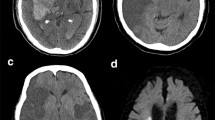Abstract
Early neurological deterioration (END) after thrombolysis occurs in 10% acute ischemic stroke (AIS) patients, and its mechanism remains unclear in majority of cases, named as unexplained END. We tested the hypothesis that penumbra/infarct growth beyond the initial penumbra might be the cause of unexplained END. We reviewed the database of AIS patients who received reperfusion therapy. Unexplained END was defined as ≥ 2-point increase of NIHSS from baseline to 24 h, without straightforward causes. For each unexplained END patient, we extracted 2 matched controls based on 4 clinical and radiological characteristics which were strongly associated with unexplained END. We defined extra-penumbra and extra-infarct as penumbra and infarct growth at 24 h beyond baseline penumbral tissue and then investigated the relationship between extra-penumbra and extra-infarct and the presence of unexplained END. Finally, 44 unexplained END patients and 88 matched controls were included. The volume of both extra-infarct (OR, 1.032 per 1-mL increase; p = 0.018) and extra-penumbra (OR, 1.070 per 1-mL increase; p < 0.001) were associated with the presence of unexplained END, while the absence of recanalization was associated with the presence of either extra-infarct or extra-penumbra (OR, 3.291; p = 0.001). Moreover, 51.4% cases with extra-penumbra at 24 h finally progressed to infarct at 7 days, and they underwent higher increase of NIHSS from 24 h to 7 days than those that did not progress to infarct at 7 days (4.0 vs 1.0; p = 0.017). Penumbra/infarct growth beyond the initial penumbra is involved in the unexplained END in AIS patients receiving reperfusion therapy.




Similar content being viewed by others
References
Haussen DC, Bouslama M, Grossberg JA, Anderson A, Belagage S, Frankel M, et al. Too good to intervene? Thrombectomy for large vessel occlusion strokes with minimal symptoms: an intention-to-treat analysis. J Neurointerv Surg. 2016.
Saver JL, Altman H. Relation between neurologic deficit severity and final functional outcome shifts and strengthens during first hours after onset. Stroke. 2012;43(6):1537–41.
Seners P, Turc G, Tisserand M, Legrand L, Labeyrie MA, Calvet D, et al. Unexplained early neurological deterioration after intravenous thrombolysis: incidence, predictors, and associated factors. Stroke. 2014;45(7):2004–9.
Seners P, Turc G, Oppenheim C, Baron JC. Incidence, causes and predictors of neurological deterioration occurring within 24 h following acute ischaemic stroke: a systematic review with pathophysiological implications. J Neurol Neurosurg Psychiatry. 2015;86(1):87–94.
Seners P, Baron JC. Revisiting ‘progressive stroke’: incidence, predictors, pathophysiology, and management of unexplained early neurological deterioration following acute ischemic stroke. J Neurol. 2017;(6):1–10.
Bang OY, Kim GM, Chung CS, Kim SJ, Kim KH, Jeon P, et al. Differential pathophysiological mechanisms of stroke evolution between new lesions and lesion growth: perfusion-weighted imaging study. Cerebrovasc Dis. 2010;29(4):328–35.
Tisserand M, Seners P, Turc G, Legrand L, Labeyrie MA, Charron S, et al. Mechanisms of unexplained neurological deterioration after intravenous thrombolysis. Stroke. 2014;45(12):3527–34.
Alawneh JA, Moustafa RR, Baron JC. Hemodynamic factors and perfusion abnormalities in early neurological deterioration. Stroke. 2009;40(6):443–50.
Neuberger U, Möhlenbruch MA, Herweh C, Ulfert C, Bendszus M, Pfaff J. Classification of bleeding events: comparison of ECASS III (European Cooperative Acute Stroke Study) and the new Heidelberg bleeding classification. Stroke. 2017;48(7):1983–5.
Schramm P, Schellinger PD, Fiebach JB, Heiland S, Jansen O, Knauth M, et al. Comparison of CT and CT angiography source images with diffusion-weighted imaging in patients with acute stroke within 6 hours after onset. Stroke. 2002;33:2426–32.
Zaidat OO, Yoo AJ, Khatri P, Tomsick TA, Kummer RV, Saver JL, et al. Recommendations on angiographic revascularization grading standards for acute ischemic stroke a consensus statement. Stroke. 2013;44(9):2650–63.
Seners P, Hurford R, Tisserand M, Turc G, Legrand L, Naggara O, et al. Is unexplained early neurological deterioration after intravenous thrombolysis associated with thrombus extension? Stroke. 2017;48(2):348–52. https://doi.org/10.1161/strokeaha.116.015414.
Lin L, Bivard A, Levi CR, Parsons MW. Comparison of computed tomographic and magnetic resonance perfusion measurements in acute ischemic stroke: back-to-back quantitative analysis. Stroke. 2014;45(6):1727–32. https://doi.org/10.1161/strokeaha.114.005419.
Funding
This work was supported by National Natural Science Foundation of China (81622017), National Key Research and Development Program of China (2016YFC1301503), Science Technology Department of Zhejiang Province (2018C04011), Chinese Cardiovascular Association-V.G fund (2017-CCA-VG-004), Natural Science Foundation of Zhejiang Province (LGF19H090021), and Basic Public Interests of Research Plan of Zhejiang Province (GF18H090006).
Author information
Authors and Affiliations
Corresponding author
Ethics declarations
All subjects had given written informed consent prior to the study, and the protocols had been approved by the human ethics committee of the second affiliated hospital of Zhejiang University, School of Medicine. Clinical investigation had been conducted according to the principles expressed in the Declaration of Helsinki.
Conflict of Interest
The authors declare that they have no conflicts of interest.
Additional information
Publisher’s Note
Springer Nature remains neutral with regard to jurisdictional claims in published maps and institutional affiliations.
Rights and permissions
About this article
Cite this article
Fu, J., Zhou, Y., Li, Q. et al. Perfusion Changes of Unexplained Early Neurological Deterioration After Reperfusion Therapy. Transl. Stroke Res. 11, 195–203 (2020). https://doi.org/10.1007/s12975-019-00723-w
Received:
Revised:
Accepted:
Published:
Issue Date:
DOI: https://doi.org/10.1007/s12975-019-00723-w




